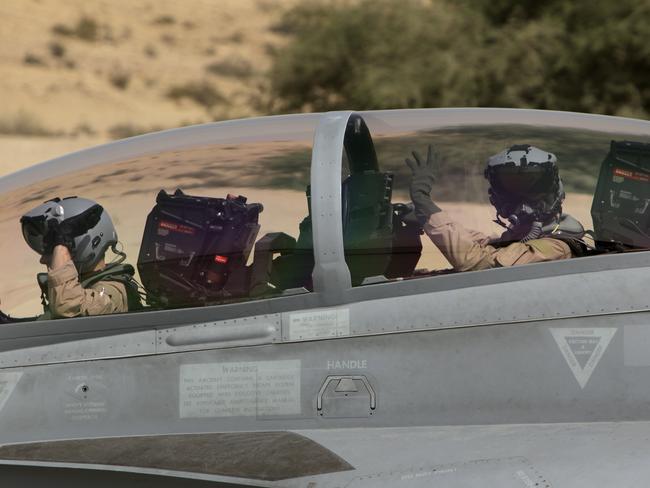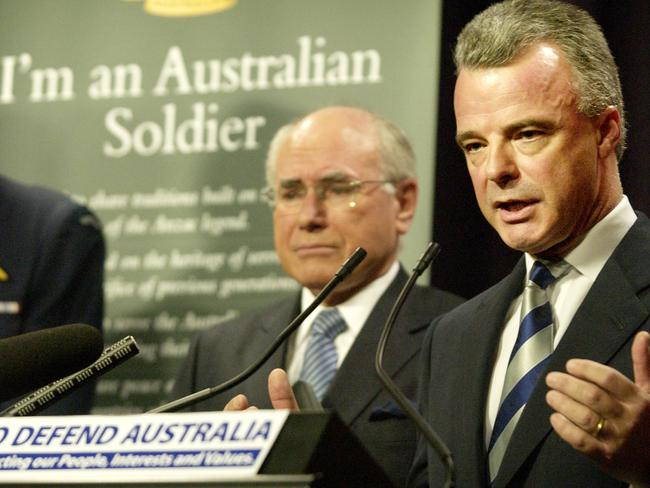Secret meeting ensured Australia had Super Hornets to strike ISIS
A SECRET meeting involving John Howard in a backroom of Parliament House ensured Australia’s first RAAF combat mission against ISIS could go ahead.
A SECRET meeting eight years ago in a backroom of Parliament House in Canberra ensured yesterday’s first RAAF combat air cover over Iraq against Islamic State terrorists could go ahead, it has been revealed.
Two RAAF F/A-18 Super Hornet flew their first missions this week, lasting six to eight hours as air cover for local ground forces, although they did not drop any bombs.
Their action followed operational missions last week by other RAAF assets in the Middle East including a Wedgetail Airborne Early Warning and Control aircraft and KC-30A Multi Role Tanker Transport.
ISIS FIGHTER: Reveals what life is like inside the terror group
REVEALED: Australia’s Top Guns loaded up with firepower

But none of their missions would have taken place but for a private meeting eight years ago in October 2006 in a suite next door to the Cabinet room in Parliament House.
Visiting London yesterday, former defence minister Brendan Nelson revealed he asked to see then Prime Minister John Howard in an urgent impromptu meeting to discuss the then perilous state of Australia’s air capability and national security.
He said while Australia was already committed to buying the American prototype F-35 fighter, a plan B was needed.

“We had to make a decision about retiring the F111 which were ageing and we were the only country in the world left flying them, we also had real problems with Boeing on the Wedgetail and the Vigilaire the ground base network centric airwarfare system, we also had to do major
centre barrel upgrades on the conventional Hornets so there were a whole series of complex moving parts to it,” he told News Corp yesterday.
In the room was Howard, his chief of staff Arthur Sinodinos, Department of Prime Minister and Cabinet Secretary Peter Shergold and a security adviser.
“I ran though it all and he (Howard) said ‘so what do you want to do?’
and I said ‘we have no choice we have to buy Super Hornets’. He said ‘okay, work it up and bring it to Cabinet’.
It was approved by Cabinet and signed off the following March.
“At the time everyone seemed critical of the decision but I was absolutely convinced we had done the right thing and I remember saying to John Howard at the time that the criticism we were getting, I was getting personally for driving the decision, I would rather have that than an Australia without air combat capability.
“You can only imagine now where we would be if we had not done it.

“In hindsight it was clearly the right thing and if we had not done it I don’t think Australia would be able to contribute to this (Islamic State mission) now.”
Mr Nelson, who is now director of the Australian War Memorial (AWM) and in London on a fact finding mission and meetings with counterparts from the Imperial War Museum ahead of 2015 World War I commemorations, said Australia’s fight against IS was the right thing to do.
“There are some truths by which we live that are worth fighting to defend and I think it would be irresponsible and delusional for us as Australians to think we can leave this to someone else,” he said.

He added as he saw the brass plaques on the AWM’s walls of all the other past theatres of conflict Australians had been involved in he knew they all involving fighting for where Australia’s national interests lay and represented the right thing to do.

“They (IS) have hijacked the good name of Islam … I think we diminish ourselves and we demean the values by which we live if we don’t stand up to this, it’s extremely important.
“This is at least a generational struggle and not just a military one, it’s about confronting and challenging what is extreme ideology.”



